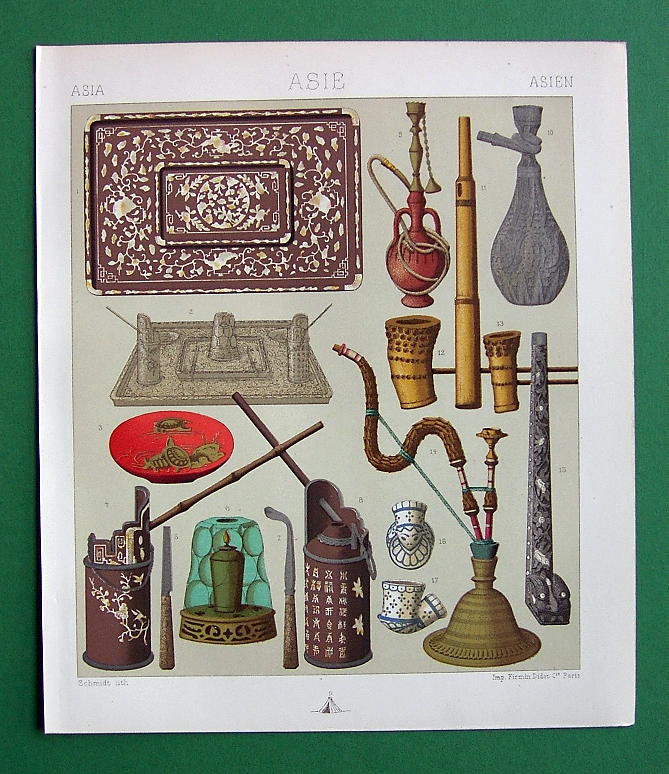

"Pipes of Asia," from an edition of Racinet, 1888
Source: ebay, Mar. 2006
"Most of the objects in this print represent accessories from the empire from Annam where the art of mother-of-pearl inlay achieved a high degree of skill. it was used in embellishing furniture, coffers, trays and also on smoking accessories. the reference is made to the figures indicated in the print: Annam Empire: Fig. 2. A smoking set, Annam Empire, Fig. 1. A smoking tray, made of wood, inlaid with mother-of-pearl, 58 cm long, Fig. 3. A small wooden bowl, lacquered, for holding tobacco, diameter is 12 cm, Fig. 4 and 8. Wooden pipes, inlaid with mother-of-pearl, equipped with silver chains, height 19 cm, Fig. 5 and 7. Steel knives for cutting pipes, Fig. 6. A bronze lamp, the flame is protected by a faceted, green colored glass cylinder. Used to light pipes, height 13 cm. India: Fig. 9. A water pipe called Gourgoury-houkka, the fittings are made of copper, the bowl of terra-cotta, the tube, called marpitch, is also made of copper, Fig. 12 and 13. Ordinary wooden pipes, rudely carved, length 18 cm. Persia: Fig. 10. A carved kalioum, made of silvery metal, height 28 cm. Rich Persian families kept a special servant, called pisch-khedmet who was responsible for caring for the kalioum. At the court of the Shah, this was a responsibility of a high dignitary, Fig. 14. Houkka, a bell shaped, metal pipe with carved ornaments, the bowl of the pipe made of terra-cotta, the tube is of carved wood, height 55 cm, Fig. 16 and 17. Ordinary pipes with bowls made of faiance, height 4,5 cm. Java: Fig. 11. A Cane opium pipe. In this type of pipe, the bowl is inside, and shows itself on the outside as a narrow opening. It is a quite primitive form of pipe. Fig. 15. A pipe made of carved wood, inlaid with mother of pearl. Height 55 cm. The craftsmanship on this pipe is very refined, and shows the knowledge of Annamite procedures. It can also be found on souvenir items from Malaysia and Borneo. Note: 1 inch equals 2,54 cm."

More pipes of Asia, from Racinet 1888
Source: ebay, Mar. 2006
"Legend: Water Pipes: Fig. 21. Narguileh of Egyptian peasant, length 60 cm, the receptacle made of cocoa nut, shaft and stem of wood, Fig. 12. Narguileh from Persia, 17-18th Century, with independent support, height 90 cm, receptacle and bowl made of metal, embellished with cloisonné enamel, metal tripod, wood stem, leather, shaft, Fig. 15. Narguileh with independent support, height 50 cm, receptacle of cocoa nut, inlaid with silver, wooden shaft, metal tripod with chiseled ornmentation, Fig. 13. Houkhah of Indian peasant of 16-17th Century, 40 cm long, bell of black metal damascened with silver, bowl made of terra-cotta, tube embellished with silk, Fig. 19. Houkhah, similar type as no. 13, height 21 cm, bell made of white and yellow metal, finely chiseled, Fig. 18. Houkhah India-persian, 16th Century, height 85 cm, bell receptacle made of black metal damascenes with silver, wooden stem, covered with ornamentation of leafed gold and silver. Metal bowl embellished with finely chiseled ornaments, Fig. 17. Kalioum from Samarkand (Russia), height 62 cm, wooden pipe, receptacle embellished with inlaid gold, painted surface provides background for ornaments, Fig. 14. Kalioum from Constantinople, height 54 cm, receptacle of enameled glass, leather stem, terra-cotta bowl, leather tube covered with silk, mouthpiece made of horn. Chibouks: Fig. 1. Pipe from Persia, length 27 cm, terra-cotta bowl, tube embellished with silk and gold filaments, stone mouthpiece, golden chain with two medallions, Fig. 4. Pipe of Arab chieftain from desert, length 82 cm, terra-cota bowl, shaft consists of the interlocking tubes, covered with silk fabric, woolen pompom can be seen in the center, mouthpiece made of composite material of zinc and tar, Fig. 7. Turkish pipe, length 33 cm, bowl made of white and yellow metal, wooden pendant, shaft of painted wood, Fig. 6. Turkish pipe, 24 cm, made of wood damascened with silver, Fig. 16. Bachi-bozouk pipe, height 5 cm, bowl carved out of root, Fig. 2,8,9,10. Terra-cotta pipes from around Baghdad and Bassorah. Cigar holders: Fig. 3. Holder from Boukkarah, length 9 cm, gilded leather, Fig. 5,11. Persian holder, no. 5 is 21 cm long, filigreed silver, mouthpiece of fine stone, no. 11 is 9 cm long, silver bowl ornamented with foliage of filigreed gold, mouthpiece of fine stone, Fig. 20. Ashtray, made of wood, diameter 6 cm, red enameled leather, has a button for closing the eopening. Note: 1 inch = 2.54 cm."